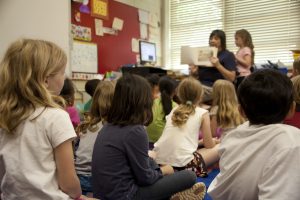
December 16, 2021, by Rupert Knight
Harnessing the power of story to promote mathematical learning
In this blog post, which was originally published on the 27th Nov, 2020 on ‘Ponderings on maths education’, Catherine Gripton and Helen J Williams explore how to harness the power of story to support mathematical learning.
How might picture and story books enhance the mathematical experience we offer young children?
All children are entitled to a strong mathematical foundation which is achieved by the integration of both child- initiated play and adult teaching through meaningful contexts. Young children are naturally mathematical problem solvers, inquirers and sense-makers. Adults encourage children to be mathematical in a range of settings and to reason and to solve mathematical problems in context. Contexts are therefore crucial for children to mathematise their experiences in a way that is meaningful to them. Story and picture books provide rich, varied, engaging contexts for mathematics that support young children’s mathematical learning (van den Heuvel-Panhuizen et al, 2014).
Historically, we are blessed with an enormous and culturally rich source of children’s literature, and the main purpose of any story or picture book is for us to enjoy both the powerful language and wonderful images with our children, over and over. Children and adults have their favourite books and enjoy discovering new books. Enjoying a book can be a solitary or social, a quiet or noisy, a calm or a highly energetic activity. This joy of engaging with a book should not be disrupted or lessened by the forcing of mathematics into the story or picture book. This can happen if mathematics, often counting, is imposed without clear reason. For example, pausing the story in order to count the legs of the characters on the page, when this is not integral to the story, can halt the flow of it and therefore the immersion of the children with it. Instead, the mathematics should arise authentically from the story or picture book context and lead to greater appreciation or enjoyment of the book. This “narrative first” approach (Russo & Russo 2018) ensures that the mathematics is led by the story (rather than by any specific curriculum requirement) and involves choosing any quality text with an engaging narrative. It is from this, that key characters and plot can be used as a context for developing rich problem-solving tasks that connect to these key components.

Finding the mathematics
Mathematics can arise authentically whilst reading a story or picture book. Children and adults might count the number of toys in the bed to predict how many will be in the bed on the next page (‘Ten in the Bed’ by Penny Dale) or might follow routes with their finger around the maze using directional language such as “up, around and through” (‘The Secret Path’ by Nick Butterworth). Mathematics can also develop from the book, where children continue, extend or re-enact the story in playful ways. They might use props, drawing or their imagination to do this, creating mathematical situations and problems to explore and solve. Understanding of the predicament of the characters, the setting or the pattern within the events of the book helps children to make meaning of the mathematics. They count, combine shapes, spot patterns and reason about the mathematics because it is important to them and to the story. In these ways, story and narrative present a rich birthplace for young children’s collaborative exploration and problem solving.
Books containing mathematical investigations
Story and picture books provide a range of authentic contexts for mathematics. The mathsthroughstories and Erikson Institute websites offer support with selecting appropriate books and guidance for how to develop mathematical learning with them. When selecting books, there are those where the mathematical possibilities are readily apparent and others where these are much more subtle. Some books are written to stimulate mathematical investigations in their own right, and these have a well-deserved place in our libraries, as they inspire rich mathematical discussions, often on every page. Amongst the best of these, we would include:
‘One is a Snail, Two is a Crab’ by April and Jeff Sayre
‘Anno’s Counting Book’ by Mitsumasa Anno
‘Tangram Cat’ by Rinck and Van Der Linden
“How Many” by Christopher Danielson
“The Art of Clean Up” by Ursus Wehrli
Books where mathematics is integral to the story
’The Doorbell Rang’ by Pat Hutchins is a picture book where the mathematics is integral to the story. Children can act this out with props, as well as playfully engage in further mathematical investigation. In this book, an unnamed quantity of cookies are shared between 2, 4, 6, and finally 12 children. There are many possibilities for mathematical exploration: How can we find out how many cookies Mum baked at the start? What other numbers of cookies would share fairly like this? What number of cookies would Grandma have to bring? How do we know? What would we do if there were 7, 11 or 13 cookies or 3 children?
Similarly, ‘Where’s Spot’? by Eric Hill includes positional language such as ‘behind’, ‘inside’ and ‘under’. This can be playfully recreated by hiding a soft toy and searching for it: Where’s teddy? Is he under the table? Is he behind the curtain? Is he on the highchair? This could be extended to taking teddy on journeys (including using ride-on toys): Where is teddy going? Is he going around the corner? And perhaps even recounting where teddy has been.

Books where the mathematics is more subtle
In other stories, the mathematics is less immediately obvious, however just as rich. ‘Little Croc’s Purse’ by Lizzie Finlay, for example, would require several readings and a discussion with the children to develop the mathematics. The discussion would include asking them “what did you notice?” and “what did you wonder?” This helps to reveal what the children have attended to, what they think is important and what they think the story is about. There are a range of possible avenues to explore mathematically. These might include: water play with Croc Monsieur’s lemonade factory (with children determining prices for different amounts of lemonade); an exploration of ‘saved’ coins in a variety of piggy banks (made or collected) with counting and comparison of money; role play with a collection of purses containing coins being weighed and amounts compared.
In ‘Socks’ by Elizabeth Lindsay and Nick Sharratt, there are images of socks on each page. Children might continue their enjoyment of the book by playing with a collection of different socks. They might be encouraged to match the patterns and the sizes, count the socks, find the right socks to fit a soft toy or an adult, fill the socks with sand, peg them on a washing line in groups of 2 or in order of length and lay them flat to make shapes on the floor by moving, flipping and rotating them (as in the book making a train, a moustache or a crocodile out of socks). Themes and ideas from books can provide a context for stimulating mathematical exploration.
Meaningful contexts for problem solving and reasoning
“The benefits of using children’s storybooks to support mathematics instruction in primary schools is well established. Muir et al. (2017) note that children’s literature can be used to engage students in the topic or lesson, contextualise important mathematical concepts and promote mathematical reasoning.”
(Russo & Russo 2018: 8)
Story contexts provide meaningful and engaging environments for setting problems for children to solve (Heathcote, Johnson & O’Neill, 1984) as characters provide parameters for the problem (such as the need for a doorway to be a specific size). The logic of the story sets the parameters for the problem and the solutions as they need to fit within the logic of the story (a remaining biscuit could be shared by breaking it in half but not an additional animal when putting them into two teams, for example). The specific context encourages children to reason and makes problem solving a worthwhile endeavour for the child. These story contexts enhance children’s problem-solving abilities, such as when using story contexts in block play (Casey et al, 2008), supporting motivation and sustained engagement to find solutions for the story characters. The narratives bring the mathematics alive for children and are as authentic as any ‘real world’ problem. There is the added benefit over everyday situations in that fictional characters can safely make mistakes and try things out without fear of reprisal and can begin again and try a new approach if needed. Children can make adaptations and corrections in the safe space of an imaginative world. This is therefore a strong pedagogical approach which supports children’s mathematical thinking, behaviours, development and well-being.
References
Casey, B.M., Andrews, M., Schindler, H., Kersh, J.E., Samper, A. & Copey, J. (2008). The development of spatial skills through interventions involving block building activities. Cognition and Instruction 26: 269-309.
Heathcote, D., Johnson, L. & O’Neill, C., (1984). Dorothy Heathcote: Collected writings on education and drama. London: Hutchinson.
Russo, T. & Russo, J. (2018). Narrative-first approach: Teaching mathematics through picture story books. Australian Primary Mathematics Classroom 23(2): 8-14.
van den Heuvel-Panhuizen, M. Robitzsch I.E. & Robitzsch, A. (2016). Effects of reading picture books on kindergartners’ mathematics performance, Educational Psychology, 36(2): 323-34.
No comments yet, fill out a comment to be the first

Leave a Reply